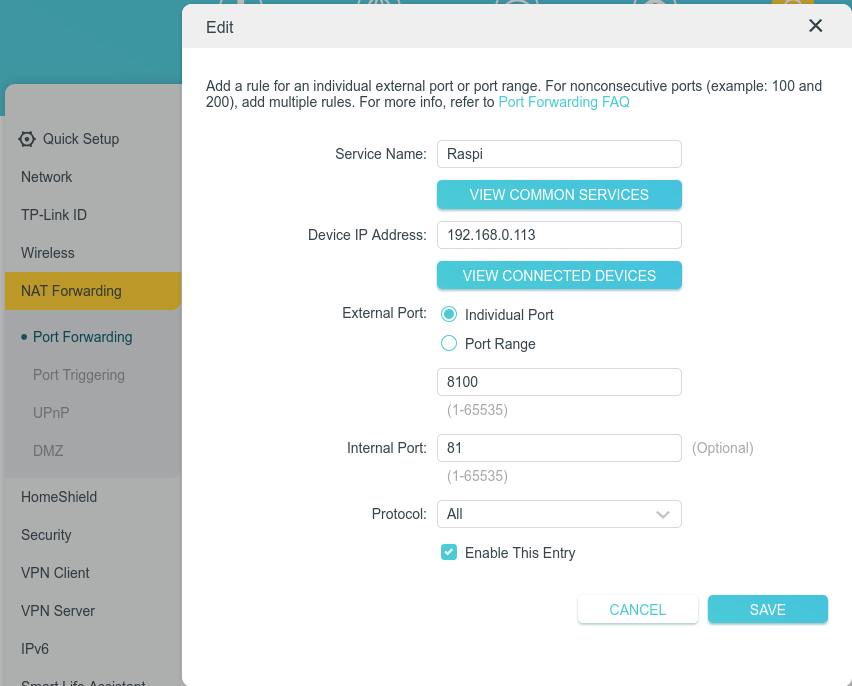I’m pretty new to selfhosting and homelabs, and I would appreciate a simple-worded explanation here. Details are always welcome!
So, I have a home network with a dynamic external IP address. I already have my Synology NAS exposed to the Internet with DDNS - this was done using the interface, so didn’t require much technical knowledge.
Now, I would like to add another server (currently testing with Raspberry Pi) in the same LAN that would also be externally reachable, either through a subdomain (preferable), or through specific ports. How do I go about it?
P.S. Apparently, what I’ve tried on the router does work, it’s just that my NAS was sitting in the DMZ. Now it works!
You need a reserve proxy. That’s a piece of software that takes the requests and puts them toward the correct endpoint.
You need to create port forwards in the router and direct 80 and 443 (or whatever you’re using) toward the host of the reverse proxy and that is listening to on those ports. If it recognized the requests are for nas.your.domain, it will forward the requests to the NAS.
Common reverse proxies are nginx or caddy. You can install it on your raspberry, it doesn’t need it’s own device.
If you don’t want that, you can create different port forwards on your router (e.g. 8080 and 8443 to the Raspi) and configure your service on the Raspi corresponding. But it doesn’t scale well and you’d need to call everything with the port and the reverse proxy is the usual solution.
There’s an issue with that first part. Do I configure it right? Should <domain>:8100 be redirected to 192.168.0.113:81 in this case?

External 80 to internal 80 and external 443 to internal 443
With this config you don’t have to deal with ports later, as http is 80, https is 443 by default.
If you run some container on port 81, you have to deal with that in the reverse proxy, not in the router. E.g. redirect something.domian.tld to 192.168.0.103:81
If you use docker check out nginxproxymanager, it has a very beginner friendly admin webui. You shouldn’t forward the admin ui’s port, you need to access it only from your lan.
This only guarantees your WANip:8100 will map to 192.168.0.113:81, and doesn’t address whether or not dns resolution is correct. I would also be weary of using port numbers on wikipedia’s known ports list, as some ISPs will filter those upstream. The last thing is that your router may not want to hairpin that traffic, so if you’re not coming in from the outside it might not be a valid test.
Thanks for the pieces of advice! Yes, I tried to connect from external (mobile) network as well.
Welcome to the wonderful world of reverse proxies!
VPN is definitely the way to go for home networks. Your router even has one built in. OpenVPN and Wireguard are good.
If you really want to expose stuff like this the proper way is to isolate your home network from your internet exposed network using a VLAN. Then use a reverse proxy, like caddy and place everything behind it.
Another benefit of a reverse proxy is you don’t need to setup https certs on everything just the proxy.
You do need a business or prosumer router for this though. Something like Firewalla or setting up a OpenWRT or OPNsense.
Synology also has there quick connect service as well. While not great if you keep UPNP off and ensure your firewall and login rate limiting is turned on it may be better then just directly exposing stuff. But its had its fair share of problems so yeah.
Consider not self hosting everything. For example if all your family cares about is private photo storage, consider using a open source E2EE encrypted service for photos on the cloud like Ente Photos. Then you can use VPN for the rest. https://www.privacyguides.org/ has some recommendations for privacy friendly stuff.
Also consider the fallout that would happen if you are hacked. If all your photos and other things get leaked because your setup was not secure was it really any better than using big tech?
If nothing else please tell me you are using properly setup https certs from Let’s Encrypt or another good CA. Using a firewall and have login rate limiting setup on everything that is exposed. You can also test your SSL setup using something like https://www.ssllabs.com/ssltest/
No truly private photos ever enter the NAS, so on that front it should be fine.
VPN is not an option for several reasons, unfortunately.
But I do have a Let’s Encrypt certificate, firewall and I ban IP after 5 unsuccessful login attempts. I also have SSH disabled completely.
SSL Test gave me a rating of A
Whispers “try proxmox”
If you mean HTTP server, what you need is a reverse proxy and name-based virtual hosts. I usually use nginx for such tasks, but you may choose another web server that has these features.
Thanks!
I recommend caddy as a webserver, it’s very powerful, but the config is super simple compared to old school stuff like nginx or apache.
Router gets the public IP. Login to it, find port forwarding option. You’ll pick a public port. IE 443 and forward it to a local IP:port combo, IE 192.168.0.101:443.
Then you can pick another public port and forward it to a different private IP:port combo.
If you want a subdomain, you forward one port to one host and have it do the work. IE configure Nginx to do whatever you want.
EDIT: or you use IPv6. Everything is a public IP.
Honestly Cloudflare Tunnels could be a very simple way to do it. I’ve always had tremendous luck with it. By using CF you can let them do all the heavy lifting instead of hosting your own… as long as you trust them.
They are a plague with how prevalent they have become.
The internet shouldn’t put all its eggs into one basket.
It’s just another centralized entity which will lead to monopolized power. It goes against what we are trying to do with federated networks like Lemmy and mastodon.
What’s a better alternative that offer good ddos protection and tunnels
You can use frp to do the same thing a CloudFlare tunnel does without giving them your unencrypted data.
You can either:
A) Use a different port, just set up the new service to run on a port that’s not used by the other service.
B) If it’s a TCP service use a reverse proxy and a subdomain.
If you go with IPv6, all your devices/servers have their own IP. These IPs are valid in your LAN as well a externally.
But it’s still important to use a reverse proxy (e.g. for TLS).
Oh, nice! So I don’t have just one, but many external IPs, one for every local device?
I really feel like people who are beginners shouldnt play with exposing their services. When you set up Caddy or some other reverse proxy and actually monitor it with something like fail2ban you can see that the crawlers etc are pretty fast to find your services. If any user has a very poor password (or is reusing a leaked one) then someone has pretty open access to their stuff and you wont even notice unless you’re logging stuff.
Of course you can set up 2FA etc but that’s pretty involved compared to a simple wg tunnel that lives on your router.
Who is externally reaching these servers?
Joe public? Or just you and people you trust?If it’s Joe public, I wouldn’t have the entry point on my home network (I might VPS tunnel, or just VPS host it).
If it’s just me and people I trust, I would use VPN for access, as opposed to exposing all these services publicly
Your stuff is more likely to get scanned sitting in a VPS with no firewall than behind a firewall on a home network
Just me and the people I trust, but there are certain inconveniences around using VPN for access.
First, I live in the jurisdiction that is heavily restrictive, so VPN is commonly in use to bypass censorship
Second, I sometimes access my data from computers I trust but can’t install VPN clients on
Third, I share my NAS resources with my family, and getting my mom to use a VPN every time she syncs her photos is near impossible
So, fully recognizing the risks, I feel like I have to expose a lot of my services.
Remember that with services facing public internet it’s not about if you get hacked but when you get hacked. It’s personal photos on someone elses hands then.
Not sure why you’re downvote, you’re absolutely right. People scan for open ports all day long and will eventually find your shit and try to break in. In my work environment, I see thousands of login attempts daily on brand new accounts, just because something discovered they exist and want to check it out.
What are you running?
If it is http based use a reverse proxy like Caddy
Update: tried Caddy, love it, dead simple, super fast, and absolutely works!
Did you also forward UDP port 443?
If not I would as well since it is used for QUIC which is supported and automatically turned on for Caddy.
For now just some experiments alongside NAS
Planning to host Bitwarden, Wallabag and other niceties on the server, and then when I get something more powerful, spin up Minecraft server and stuff
I’ll be honest, if you aren’t planning on sharing with others, I’d recommend switching to something like wireguard to connect back into your house instead of exposing everything publicly. Some firewalls have wireguard built in, so you can setup the VPN easily. But then all you have to do is keep your VPN endpoint safe to keep your internal network protected from the Internet, instead of having to worry about the security of everything you expose.
That’s a good piece of advice, but due to several considerations (extreme censorship interrupting VPN connections, family using NAS for automatic backups, and some others) I cannot go that route.
There’s nothing saying you can’t have ports forwarded for the NAS, and have a VPN for everything else. Censorship may be a problem, but those more often block VPN services like NordVPN, not protocols. So running your own is less likely to be stopped. That said, of course comply with local laws, I don’t know where you live or what’s legal there.
If you really want multiple things exposed at the same time, you have two options(which can be used in combination if needed/wanted):
- A reverse proxy. I use caddy. I give it a config file that says what address and port binds to what hostname, and I forward port 443/80 to it. That works great for web content.
- Use custom ports for everything. I saw someone else walking you through that. It works, but is a little harder to remember, so good notes will be important.
I still recommend against forwarding a lot of ports as a beginner. It’s very common for software and web apps to have security vulnerabilities, and unless you are really on top of it, you could get hit. Not only does that put all your internal devices at risk, not just the one that was original breached, it also will likely become part of a botnet, so your local devices will be used to attack other people. I’d recommend getting confident with your ability to maintain your services and hardening your environment first.
It’s not illegal to use VPN in my area, but connections are blocked on a protocol level, both through OpenVPN and Wireguard.
I already managed to make caddy work, so, hooray!
I also found a setting on my router that fully isolates certain devices from the local network. I want to put the server in there, so that the rest of my LAN is not under threat. I also want to figure out VLANs.
I am not an expert on security and I don’t know how to setup ddns, but I simply use Tailscale VPN to access my RPi4 homeserver running Umbrel from outside of my home, I simply installed Tailscale in my Umbrel and in my phone, and when I want to access from my phone Immich, Nextcloud or any other app running on my Umbrel. I simply enable the Tailscale VPN. Maybe it has some limitations, but is the simpler way I found, and based on what I read, it is more secure than exposing a port in the router, but not sure.
I would be fairly comfortable running a direct WireGuard connection even without Tailscale, but my location and use case simply won’t allow me to.
Your setup is valid, nothing wrong with it, and yes, it is more secure. Just can’t be used in my case.
What do you mean by blocked at a protocol level? You might give it a try on a random port to see what happens.
You could also look into port knocking. It is dated but still worth while.
I mean any connection through these protocols is just not working over the Internet. DPI equipment detects respective packets and cuts the connection, irrespective of the port you assign.
NAT translation, i use my openwrt router for that









